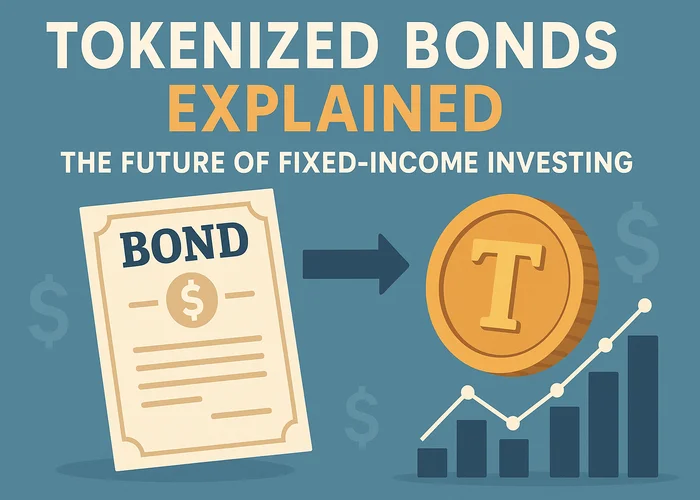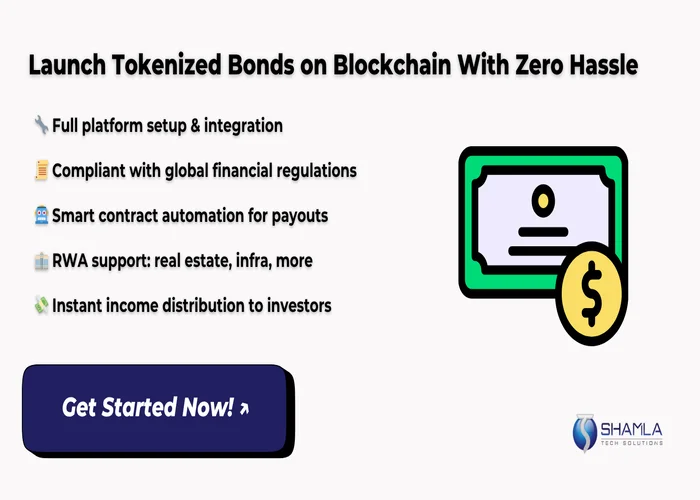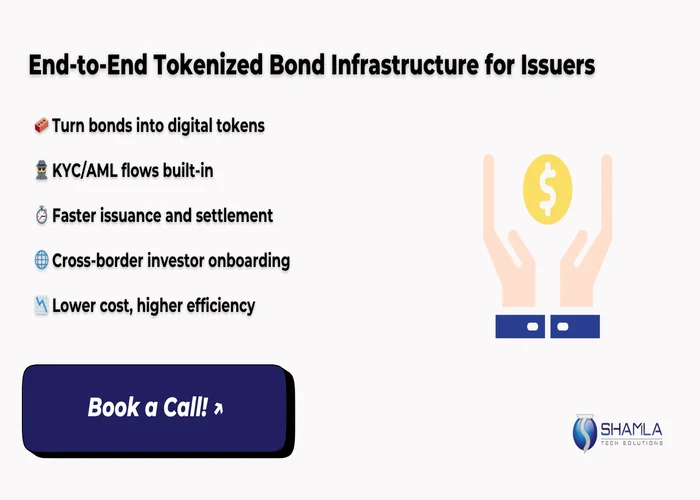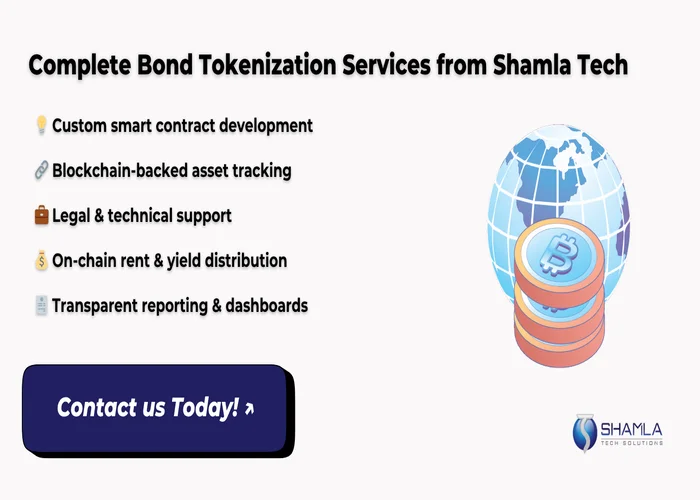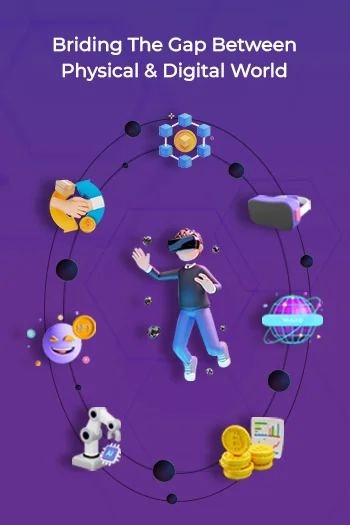Tokenized bonds are digital versions of normal bonds that link debt to a chain of records, turning traditional loans into blocks on a shared ledger. It brings a new phase for fixed‑income investing by trimming steps and speeding trades. Under this model, blockchain in bond markets tracks ownership clearly, shields data, and runs rules automatically.
By using real world asset tokenization, these bonds mirror loan values exactly, letting users hold pieces of high‑grade debt with greater ease and lower entry points. They expand market access worldwide instantly and affordably.
What Are Tokenized Bonds?
Tokenized bonds are digital versions of debt notes issued by governments or companies. Tokenized bonds create digital tokens on a blockchain to represent a bond’s value. Each token represents a portion of the debt and can be bought and sold online. This setup uses tokenization on blockchain to record transfers in real time and cut out clearing houses.
These tokens act as security tokens, which meet rules for debt and protect investors. Other tokenized assets, including tokenized bonds and real estate, use a similar method, proving ownership with a digital key. With tokenized bonds, interest payments can go straight to token holders, cutting costs and speeding debt moves.
Key Differences between Tokenized Bonds and Standard Bonds
Aspect | Tokenized Bonds | Standard Bonds |
Record keeping | Digital ledger on blockchain | Centralized registry at an agent |
Trading platform | Peer‑to‑peer online exchanges | Secondary markets via brokers |
Settlement time | Seconds to minutes | Days through clearing networks |
Minimum investment | Small fractions possible | Often large minimum lots |
Transparency | Real‑time tracking of ownership transfers | Periodic reporting by intermediaries |
How Do Tokenized Bonds Work?
1. Issuance and Token Creation
2. Trading on Digital Markets
3. Settlement and Clearing
4. Interest and Maturity Handling
The Role of Blockchain in Bond Markets
1. Digital Recordkeeping
Blockchain in bond markets delivers an exact digital record for each debt instrument. A shared ledger records bond issuance, transfers, and payoffs in real time. This design removes slow paper workflows and cuts out middle actors like clearing firms. Smart contracts enforce rules for interest and principal distribution automatically.
In this model, issuers manage debt efficiently while investors view all activities at once. It lowers operational errors, accelerates trade execution, and reduces fees. With minimal capital requirements, participants gain market access securely, increasing liquidity and transparency for global debt funding worldwide immediately.
2. Automated Launch Process
Bond issuance on blockchain simplifies debt launch by coding terms into smart contracts. Issuers define face value, coupon rate, maturity date, and redemption conditions within a contract template. Once approved by regulators, tokens generate automatically, representing debt units. Each token links to a unique identity, ensuring compliance and preventing fraud.
Investors purchase tokens by sending funds to a contract address, triggering automatic allocation. This removes manual record entry and central registry updates. Real time monitoring tracks all token flows, giving issuers precise oversight. By using bond issuance on blockchain, firms cut issuance time from days to hours slashing administrative costs.
3. Asset Fractionalization
Bond issuance on blockchain simplifies debt launch by coding terms into smart contracts. Issuers define face value, coupon rate, maturity date, and redemption conditions within a contract template. Once approved by regulators, tokens generate automatically, representing debt units. Each token links to a unique identity, ensuring compliance and preventing fraud.
Investors purchase tokens by sending funds to a contract address, triggering automatic allocation. This removes manual record entry and central registry updates. Real time monitoring tracks all token flows, giving issuers precise oversight. By using bond issuance on blockchain, firms cut issuance time from days to hours slashing administrative costs.
4. Issuer & Investor Benefits
Issuers find bond issuance on blockchain improves process control and lowers costs. Automated ledger entries remove manual tasks. Regulators can audit each transaction on a visible platform. Investors benefit from instant trade settlement and real time price feeds. Blockchain in bond markets gives trust by making every transfer transparent and irreversible.
Fractional token design expands buyer pools by allowing small investments. Smart code enforces compliance rules during transfers. Custody risks drop because tokens sit in digital wallets instead of paper certificates. This combined model speeds up funding cycles and reduces counterparty risk, enabling a more open and efficient fixed‑income marketplace.
5. Secondary Market Infrastructure
Tokenization on blockchain reshapes secondary debt trading by hosting tokens on exchanges. Brokers post buy and sell orders directly within digital order books. Matching engines execute trades in milliseconds, reflecting market depth instantly. Participants settle transactions on the same chain, avoiding separate clearing steps. Blockchain in bond markets synchronizes updates, preventing failed settlements and reducing capital reserves.
Custody services automate key management with hardware wallets and multisignature controls. Compliance logic builds KYC and AML checks directly into the trading process. This unified infrastructure cuts post‑trade risk, trims reconciliation duties, and clears the way for 24/7 bond trading across borders, boosting market resilience.
6. Governance & Standards
Governance and regulation pose challenges for RWA tokenization and debt token markets. Legal frameworks must adapt to digital asset rules and cross‑border token flows. Regulators require audit trails, which blockchain ledgers inherently provide. Standardizing token schemas and metadata ensures interoperability across platforms. Wallet providers and custodians need security standards to protect investor assets. Market participants must upgrade infrastructure for high throughput and low latency. Education for issuers and investors reduces friction when adopting new workflows. As regulators and industry bodies align on guidelines, RWA tokenization can scale. This paves the way for digital debt markets and deeper integration with traditional finance.
Tokenized Bonds: Fixed-Income Investing Meets DeFi
1. Decentralized Finance (DeFi) Platforms for Fixed‑Income Investing
Decentralized Finance (DeFi) brings bond markets onto public ledgers, letting users buy tokenized bonds as security tokens without banks. Platforms list digital debt notes, showing yield rates and maturity dates. Investors connect wallets, review bond details, and stake funds in seconds. Key perks include:
- Direct access to bond offers
- Lower entry limits for small investors
- No manual paperwork or middleman fees
Issuers launch bonds quickly on chain, and investors see live data on pricing and availability.
2. Automated Interest Distribution
Smart contracts power interest payments instantly. After buying a tokenized bond, holders receive coupon payments coded into a contract. On each payment date, the contract:
- Calculates amounts per token held
- Sends funds to user wallets
- Logs payments on the ledger
Investors track payment history in their wallet interface. Automated interest distribution cuts administrative work for issuers and guarantees investors get funds without delay or missed dates.
3. DeFi Liquidity Pools and Tokenized Assets
DeFi liquidity pools let holders stake tokenized assets to earn extra yield. Bond tokens and other debt tokens can join pools alongside stablecoins. Pool features:
- Continuous trading without order books
- Yield farming rewards on top of bond coupons
- Easy in‑and‑out access via smart contracts
This model turns static bond holdings into active yield sources, enriching fixed‑income investing with DeFi’s composable tools.
4. On‑Chain Transparency and Audit Trails
Tokenized bonds live on a shared ledger, so every transfer, payment, or balance change is public. Users and regulators can:
- Verify token ownership in real time
- Trace fund flows across chains
- Confirm contract code matches issuance terms
Investors no longer rely on slow reports from custodians or registrars. Instead, they review blockchain data directly, strengthening confidence in bond markets and ensuring tokenized bonds meet all stated conditions without hidden adjustments.
5. Risk Controls and RWA Tokenization Compliance
DeFi protocols integrate risk checks and KYC steps into bond contracts. Issuers use RWA tokenization to tie tokens to real assets or credit lines. Compliance features include:
- Whitelisting approved wallet addresses
- Cap on token holdings per investor
- Automated lockup periods for new issues
These controls enforce regulations on‑chain, reducing fraud risks. Fixed‑income investing becomes more accessible while respecting local rules. By combining real world asset tokenization with DeFi tools, markets gain speed, safety, and wider participation in secure bond offerings.
Institutional Investors in Tokenized Assets
1. Demand for Liquidity and Efficiency
Institutional investors in tokenized assets seek faster trades and lower costs. Tokenized bonds offer real‑time settlement on digital ledgers, cutting days of wait into minutes. This boosts liquidity for large debt holdings and supports efficient fixed‑income investing. By using security tokens, firms move funds peer‑to‑peer without central clearing houses.
Digital records update instantly, so portfolio managers see positions live. Institutions tap tokenized bonds to rebalance books quickly and free up capital. This shift from slow legacy systems to on‑chain markets meets demands for speed, transparency, and lower counterparty risk in modern debt trading.
2. Regulatory Readiness and Compliance
Regulators now accept real world asset tokenization services under clear guidelines. Institutional investors in tokenized assets benefit from built‑in compliance layers in smart contracts. Wallet whitelists enforce know‑your‑customer checks before funds move. Automated limits guard against concentration risks. Issuers embed rules for tax reporting and investor accreditation directly into each token’s code.
Tokenized bonds carry compliance logic that checks transfers against local laws, reducing manual audits. This design aligns digital debt with existing financial rules, giving institutions confidence to expand fixed‑income investing into blockchain channels without facing legal gaps or enforcement delays.
3. Infrastructure Maturation
Core platforms now support high‑volume issuance of tokenized bonds and other debt notes. Institutional investors in tokenized assets leverage mature node networks that scale to thousands of daily transactions. API‑driven services connect issuers’ accounting systems to on‑chain records. These bridges let treasury systems push coupon details to digital contracts automatically.
As infrastructure providers refine uptime and throughput, fixed‑income investing on distributed ledgers reaches institutional performance standards. Reliable networks and clear support models are key reasons large firms allocate capital to tokenized bonds.
4. Portfolio Diversification Strategies
Institutions widen portfolios by adding tokenized bonds alongside stocks and traditional debt. Token granularity lets managers buy small tranches of corporate or sovereign debt they could not access before. This drives more balanced risk‑return profiles. Smart contracts accurately monitor income payments and principal returns, helping with better forecasting.
By mixing tokenized bonds with loans, real estate tokens, and tokenized assets, firms spread exposure across real world asset classes. This strategy taps global capital markets without extra middlemen. Institutional investors in tokenized assets gain custom risk controls and novel income sources, enhancing resilience in varied market cycles.
The Future: RWA Tokenization Across Various Sectors
Fractional Ownership Models
Automated Property Management
Global Market Access
Enhanced Compliance and Security
Improved Liquidity and Valuation
Conclusion
Tokenized bonds will redefine capital markets by enabling peer-to-peer liquidity, real-time audit trails, and automated compliance. This shift transforms fixed-income investing into an efficient, transparent ecosystem, lowering barriers and reducing costs. As blockchain protocols mature globally, digital debt instruments will drive broader financial inclusion and strengthen secure cross-border funding networks.
Shamla Tech is a top RWA tokenization company offering real world asset tokenization services with parameters tuned for security, compliance, and performance. Our APIs link legal records to smart contracts, enforce KYC/AML rules, and support secure high transaction throughput. We provide customizable token templates for debt notes, equity stakes, and instruments to fit diverse issuer needs.
Contact us today to Launch Tokenized Bonds or Real-World Assets with full compliance!

